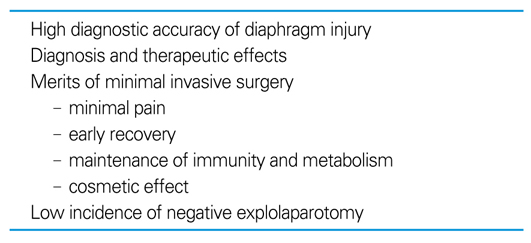 |
 |
- Search
| J Korean Med Assoc > Volume 50(8); 2007 > Article |
Abstract
Early evaluation of the abdomen is a challenging component of the initial assessment of the injured patients. Whenever an emergency physician suspects abdominal injury based on history and physical examination, it is very important to contact with trauma surgeons as soon as possible. If emergency physicians get ETA (Estimated Time of Arrival) information from paramedics, they should deliver it to trauma surgeons before patients' arrival. The resuscitation according to the primary phase of ATLS (Advanced Trauma Life Support) should be performed in hemodynamically unstable patients. And also, bed-side FAST (Focused Assessment Sonography in Trauma) should be done to evaluate the presence of hemoperitoenum and intra-abdominal organ injury. If FAST is not available at resuscitation room, DPL (Diagnostic Peritoneal Lavage) is recommended instead of FAST. Although computed tomography (CT) scan is a very accurate tool in the diagnostic aspect, it is not recommended in hemodynamically unstable patients. During resuscitation, essential tests such as electrocardiogram (ECG), blood typing with cross matching, complete blood cell counts, serum electrolyte, and urinalysis should be done for operation. In all female patients at childbearing age, a blood test or urine pregnancy test is indicated. To decompress the stomach and bladder, a gastric tube and urinary catheter should be inserted with caution. In case of penetrating abdominal trauma, emergency physicians and trauma surgeons can evaluate the presence of intra-abdominal injuries by CT scan, local wound exploration, celiotomy, and laparoscopy. However, explolaparotomy under general anesthesia is usually recommended in hemodynamically unstable patients.
References
1. American College of Surgeons Committee on Trauma. Abdominal Trauma. Advanced Trauma Life Support 2007;7th ed. American College of Surgeons. 131-145.
2. Hong ES. Korean Traumatology Society. Focused Assessment Sonography in Trauma. Advanced Trauma Life Support 2005;2nd ed. Seoul: Kunja Co. 92-106.
3. Choi YB. Korean Traumatology Society. Abdominal Trauma. Advanced Trauma Life Support 2005;2nd ed. Seoul: Kunja Co. 175-188.
4. Choi YB, Lim KS. Therapeutic laparoscopy for abdominal trauma. Surg Endosc 2003;17:421-427.
- TOOLS
-
METRICS

-
- 0 Crossref
- Scopus
- 1,205 View
- 4 Download
-
Related articles in
J Korean Med Assoc -
Acute Low Abdominal Pain1997 October;40(10)
Upper Abdominal Pain1998 March;41(3)
Jaundice and Abdominal Pain1998 November;41(11)













